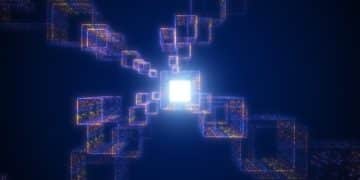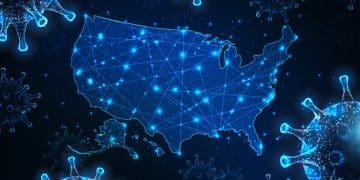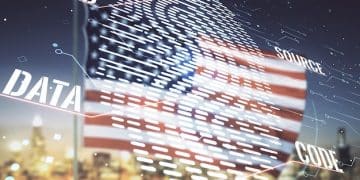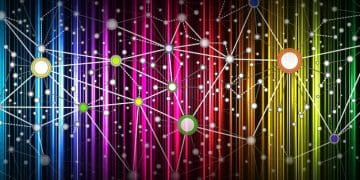Quantum Computing’s Impact on US Data Security by 2025

By 2025, quantum computing will significantly challenge existing cryptographic standards, necessitating a rapid transition to quantum-resistant algorithms to safeguard sensitive US data and critical infrastructure from potential breaches.
The dawn of the quantum era is upon us, and with it comes a paradigm shift in technological capabilities. A pressing question reverberates across national security and industry: How Will Quantum Computing Impact US Data Security by 2025? This isn’t merely a theoretical exercise; it’s an urgent assessment of emerging threats and the accelerated need for robust defenses.
the Quantum Threat Landscape by 2025
By 2025, while large-scale, fault-tolerant quantum computers (FTQCs) capable of breaking current asymmetric encryption standards like RSA and ECC may not be universally prevalent, their imminent development casts a long shadow. The critical concern isn’t just their existence, but their potential for rapid advancement and the “harvest now, decrypt later” threat.
This approach involves adversaries collecting encrypted data today, knowing they will gain the computational power to decrypt it in the near future. This makes the year 2025 a pivotal threshold, where preparatory measures become not just advisable, but imperative. The quantum threat is asymmetric, meaning a single, powerful quantum computer could undermine widespread conventional security.
the Shor’s and Grover’s Algorithms
Two quantum algorithms pose particular threats to current data security. Shor’s algorithm, discovered by Peter Shor, can efficiently factor large numbers and solve discrete logarithm problems, the mathematical underpinnings of RSA and ECC. This would render most public-key cryptography ineffective.
- Shor’s Algorithm: Directly targets and can break widely used asymmetric encryption methods like RSA and ECC, essential for securing web communications, digital signatures, and financial transactions.
- Grover’s Algorithm: Offers a quadratic speedup for searching unsorted databases. While it doesn’t break symmetric encryption (like AES) outright, it significantly reduces the effective key length, requiring longer keys to maintain the same level of security.
Understanding these algorithms is crucial for grasping the urgency of the quantum threat. Their implications extend beyond theoretical computer science, directly impacting the integrity and confidentiality of sensitive data across all sectors.
Cryptographic Vulnerabilities Exposed
The reliance on current cryptographic primitives means that a successful quantum attack could have cascading effects. Everything from secure remote access to government communications, financial transactions, and critical infrastructure control systems could be compromised.
The transition period itself introduces new vulnerabilities. As organizations begin to implement quantum-resistant solutions, the complexity of managing mixed cryptographic environments will increase, creating new potential attack vectors for sophisticated adversaries.
In essence, 2025 represents a critical juncture where the theoretical threat of quantum computing transitions into tangible risk, demanding a proactive and comprehensive approach to data security.
accelerating Quantum-Resistant Cryptography (QRC) Adoption
The race to develop and adopt quantum-resistant cryptography, also known as post-quantum cryptography (PQC), is intensifying dramatically as 2025 approaches. The U.S. government, through agencies like NIST (National Institute of Standards and Technology), is at the forefront of this global effort, pushing for the standardization of new algorithms.
NIST’s PQC standardization process, which began over seven years ago, aims to identify and approve algorithms that can withstand both classical and quantum attacks. This process is complex, involving rigorous scrutiny from cryptographers worldwide to ensure the chosen algorithms are robust and practical for widespread deployment.

nist’s Standardization Efforts and Timeline
NIST has been evaluating various cryptographic candidates, categorized by the mathematical problems they rely on, such as lattice-based cryptography, code-based cryptography, and multivariate polynomial cryptography. The selection of the initial set of standards concluded in 2022, with several algorithms moving towards finalization.
- CRYSTALS-Kyber: Selected for key encapsulation mechanisms (KEMs), crucial for establishing secure sessions.
- CRYSTALS-Dilithium: Chosen for digital signatures, vital for authentication and integrity of data.
- SPHINCS+: An alternative digital signature scheme, offering different security trade-offs.
By 2025, it is anticipated that these initial standards will be ratified, leading to their broader integration into commercial and governmental systems. However, the true challenge lies in the rapid, large-scale implementation across diverse IT infrastructures.
Migration Challenges and Urgency
Migrating to QRC is not a simple software update. It requires a comprehensive overhaul of cryptographic components embedded in hardware, software, and protocols across entire ecosystems. This process, often referred to as “crypto-agile” transformation, demands foresight and significant investment.
The urgency stems from several factors: the “harvest now, decrypt later” threat, the long lifespan of critical infrastructure, and the complexity of replacing cryptographic primitives in legacy systems. Procrastination risks leaving vast amounts of sensitive data vulnerable to future quantum attacks.
Organizations must begin inventorying their cryptographic assets, assessing their exposure, and developing detailed migration roadmaps. This proactive stance is essential to mitigate the quantum risk before it fully materializes, protecting US data security from emerging threats.
impact on critical infrastructure and Government Data
The ramifications of quantum computing extend profoundly to the security of critical infrastructure and government data within the US. These sectors are uniquely vulnerable due to their long operational lifespans, reliance on legacy systems, and the immense value of the data they safeguard.
By 2025, while direct quantum attacks on live systems might still be rare, the preparatory phase for such attacks—namely, data harvesting and reconnaissance—will be well underway. This timeline necessitates immediate, decisive action to reinforce the digital bulwarks protecting national assets.
national Security Implications
For national security, the ability of a quantum computer to break current encryption could compromise virtually all classified communications, intelligence data, and military operations. This threat level necessitates unprecedented levels of vigilance and investment in quantum-resistant solutions.
- Intelligence Agencies: Vulnerable to decryption of historical and current intelligence, potentially exposing sources and methods.
- Military Communications: Risk of interception and decryption of strategic and tactical communications, undermining operational security.
- Government Databases: Sensitive personal data, research, and proprietary information stored by various agencies could be compromised.
The strategic advantage held by nations developing quantum capabilities could be asymmetric, posing a significant geopolitical threat. The US must ensure its defensive capabilities evolve at a pace commensurate with this emergent threat.
protecting Critical Infrastructure
Critical infrastructure sectors—energy grids, financial systems, transportation networks, and public health services—are particularly at risk. A successful quantum attack could disrupt essential services, leading to catastrophic economic and social consequences.
Many operational technology (OT) systems within critical infrastructure were designed without robust security in mind, or rely on outdated cryptographic protocols with extremely long lifecycles. Updating these systems presents substantial logistical and financial challenges, but the alternative is far more dire. Organizations operating in these vital sectors must integrate quantum readiness into their cybersecurity strategies, focusing on resilience and continuity over outright prevention in some cases, given the difficulty of rapid wholesale replacement of embedded systems.
The year 2025 acts as a pivotal marker, underscoring the urgent need for a comprehensive national strategy to secure these foundational elements against the quantum threat.
economic and financial Sector Vulnerabilities
The economic and financial sectors are especially vulnerable to the quantum threat, given their heavy reliance on secure digital transactions, confidential data storage, and the pervasive use of public-key infrastructure. By 2025, the potential for quantum attacks to disrupt global markets and compromise sensitive financial information will be a tangible concern for institutions globally, and particularly within the US.
The integrity of financial systems relies on unwavering trust in cryptographic security. Any significant erosion of this trust due to quantum computing capabilities could trigger widespread panic, market instability, and devastating financial losses.
securing Financial Transactions and Data
Every online transaction, from simple credit card purchases to complex interbank transfers, is secured by cryptographic protocols. With quantum computers capable of breaking these, the very foundation of digital finance would be jeopardized.
Banks, stock exchanges, and other financial institutions hold vast amounts of highly sensitive data: customer records, proprietary trading algorithms, investment strategies, and intellectual property. The compromise of such data could lead to identity theft on an unprecedented scale, corporate espionage, and systemic financial fraud.
- Customer Data: Account numbers, personal identification, transaction histories at risk.
- Intellectual Property: Trading models, proprietary software, and strategic financial plans could be stolen.
- Transaction Integrity: Non-repudiation and authenticity of financial transactions could be undermined.
The financial sector historically adopts new technologies slowly due to regulatory burdens and inherent risks. This cautious approach, while prudent for stability, could become a detriment in the face of rapidly advancing quantum capabilities. Institutions need to balance risk aversion with the imperative for timely cryptographic upgrades.
investments in Quantum Security Solutions
Recognizing the looming threat, significant investments are already being channeled into quantum security solutions within the financial domain. This includes funding for research into new cryptographic algorithms, the development of secure quantum key distribution (QKD) networks, and the integration of quantum-resistant modules into existing IT infrastructure.
Beyond technological solutions, the sector is also focusing on new regulatory frameworks and collaborative efforts between government and private entities. By 2025, proactive financial institutions will be engaged in pilots and early deployments of QRC, understanding that securing their digital assets today is paramount for their continued operation tomorrow.
The challenge is immense, but the sector’s adaptability and resourcefulness will be tested as it navigates the transition to a quantum-safe future.
the Role of Quantum Key Distribution (QKD) and Randomness
While Quantum-Resistant Cryptography (QRC) focuses on algorithmic solutions that can run on classical computers, Quantum Key Distribution (QKD) offers a fundamentally different approach to secure key exchange, leveraging the principles of quantum mechanics. By 2025, QKD is expected to play a niche, but crucial, role in securing highly sensitive communications. Additionally, quantum random number generators (QRNGs) are gaining prominence for generating truly unpredictable cryptographic keys.
Unlike QRC, which is designed to resist quantum computer attacks on existing cryptographic primitives, QKD provides theoretically unhackable key distribution, though it has practical limitations in terms of distance and infrastructure requirements. Its implementation can complement, rather than replace, QRC.
understanding QKD’s Strengths and Limitations
QKD works by exchanging cryptographic keys using individual light particles (photons) that are encoded with quantum properties. Any attempt to eavesdrop on these photons alters their state, immediately alerting the communicating parties. This “unhackable” characteristic is a significant advantage.
- Absolute Security: Based on the laws of physics, making it theoretically impervious to current and future computational attacks.
- Distance Limitation: Photons lose their quantum properties over long distances, limiting QKD range without trusted relays.
- Infrastructure Cost: Requires dedicated fiber optic lines or free-space optical links and specialized hardware, making widespread deployment expensive.
By 2025, QKD will likely be deployed in specialized, high-security environments, such as critical government communications, interbank financial transfers where extreme confidentiality is paramount, and secure links for critical infrastructure control systems. It won’t be a universal solution for all data security needs.
the Importance of Quantum Random Number Generators (QRNGs)
Good cryptography relies on truly random numbers for key generation and other security parameters. Classical pseudo-random number generators (PRNGs) are deterministic and thus predictable under certain conditions, making them potentially vulnerable. QRNGs, which harness the inherent unpredictability of quantum phenomena, offer a superior alternative.
By 2025, the integration of QRNGs into cryptographic modules will become more common, enhancing the strength and unpredictability of generated keys. This move will significantly bolster cryptographic security, providing a truly quantum-safe foundation for secure communications and data protection. QRNGs are a more immediately scalable quantum technology than full QKD networks, offering a pragmatic enhancement to data security in the near term.
Both QKD and QRNGs underscore a multi-faceted approach to quantum security, where complementary technologies are deployed to create a highly resilient data security posture for the US.
policy, Regulation, and International Collaboration
The quantum threat is not merely a technological challenge; it is a complex geopolitical and regulatory one. By 2025, the US government’s proactive role in shaping policy, establishing regulations, and fostering international collaboration will be crucial to securing national data against the advent of quantum computing.
A unified approach, driven by clear policy directives and supported by international partnerships, is essential to ensure a coordinated and effective transition to a quantum-safe cyber landscape.
government Initiatives and Executive Orders
The US government has already taken significant steps. Executive orders and legislative initiatives underscore the urgency of addressing the quantum threat across federal agencies and critical sectors. These mandates often require federal organizations to inventory their cryptographic systems, identify vulnerabilities, and begin planning their migration to QRC.

Such directives aim to accelerate the adoption of NIST-standardized algorithms and promote “crypto-agility,” ensuring that systems can be quickly updated as new and more robust quantum-resistant solutions emerge. The year 2025 will see these mandates firmly established and their initial implementation phases well underway.
international Cooperation and Standards
Data security, particularly against a global threat like quantum computing, cannot be solved by any single nation. International collaboration is vital for several reasons:
- Standardization: Ensuring interoperability of quantum-resistant solutions across borders requires globally recognized standards, preventing fragmentation.
- Threat Intelligence Sharing: Sharing information about quantum advancements and potential threats allows for a more robust collective defense.
- Joint Research and Development: Pooling resources and expertise accelerates the development of effective countermeasures and new technologies.
Collaborations with allies, particularly through bodies like NATO and various bilateral agreements, are fundamental to developing a collective quantum-safe strategy. The exchange of research findings, best practices, and even hardware development, can significantly strengthen the global defensive posture against quantum adversaries.
By 2025, these political and collaborative efforts will be as important as the technological advancements in determining the resilience of US data security against the quantum challenge.
preparing for the Post-Quantum Era: Beyond 2025
While 2025 is a crucial near-term milestone for US data security in the face of quantum computing, the transition to a truly post-quantum era is an ongoing journey extending far beyond this date. The actions taken now are foundational for future resilience, necessitating a long-term strategic vision that anticipates evolving threats and technological shifts.
The goal isn’t just to survive the initial quantum冲击, but to thrive in a world where quantum computational power is an inherent part of the technological landscape, requiring adaptive and future-proof security paradigms.
continuous Adaptation and Innovation
The cryptographic landscape is ever-evolving. Post-quantum algorithms, while robust today, might face new vulnerabilities as quantum computing theory advances. Therefore, continuous adaptation and innovation will be paramount. This includes ongoing research into new mathematical problems for cryptography, refining existing QRC algorithms, and exploring novel quantum security paradigms.
Organizations in the US, across both government and industry, must embed “crypto-agility” into their core operational philosophy. This means designing systems that can easily swap out cryptographic primitives and protocols, ensuring they can adapt quickly to emerging threats or improved PQC standards without requiring complete overhauls.
Investing in domestic quantum research and development capabilities is also critical. This ensures the US remains at the cutting edge of quantum technology, both defensively and offensively, maintaining a strategic advantage in the cyber domain.
the Human Element: Skills and Awareness
Technology alone is insufficient. A critical component of preparing for the post-quantum era is developing the human capital necessary to understand, implement, and manage quantum-safe systems. This requires significant investment in education and training across various disciplines:
- Crypotgraphers and Mathematicians: To develop and analyze new algorithms.
- Quantum Engineers: To build and maintain quantum hardware.
- Cybersecurity Professionals: To implement and manage QRC solutions in real-world systems.
- Policy Makers: To understand the implications and create effective regulatory frameworks.
Raising awareness among decision-makers and the general public about the quantum threat and the importance of proactive measures is also vital. A well-informed populace and leadership are better equipped to support the necessary investments and policy changes required for a successful transition.
Beyond 2025, the vision for US data security involves a resilient, adaptable, and highly skilled ecosystem prepared to navigate the complexities and opportunities of the full quantum age, ensuring the nation’s digital sovereignty and safety.
| Key Aspect | Brief Impact Overview by 2025 |
|---|---|
| 📊 Cryptographic Vulnerabilities | Existing public-key encryption (RSA, ECC) faces impending threat from quantum algorithms like Shor’s, necessitating urgent migration. |
| 🛡️ QRC Adoption Acceleration | NIST’s PQC standards will be finalized and initial widespread deployment will commence in critical government and private sectors. |
| 🏛️ Critical Infrastructure & Gov Data | These sectors are prioritizing quantum-resistant upgrades due to long asset lifespans and high data value, driven by federal mandates. |
| 🌐 International Collaboration | Crucial for developing global QRC standards and coordinating defense strategies against a shared, evolving quantum threat. |
frequently asked questions about quantum computing and US data security
Not necessarily all encryption by 2025. While Shor’s algorithm poses a significant threat to widely used asymmetric encryption like RSA and ECC, symmetric encryption (e.g., AES-256) is generally considered to be more robust against quantum attacks, though it may require larger key sizes. The primary concern by 2025 is the “harvest now, decrypt later” threat where encrypted data is collected today for future decryption.
Post-Quantum Cryptography (PQC) refers to cryptographic algorithms designed to be secure against both classical and quantum computers. By 2025, the US, through NIST, will have standardized several PQC algorithms, and their initial deployment in critical government and private sectors will be underway. However, widespread readiness and full migration are complex, multi-year processes that will extend beyond 2025.
Quantum computing could severely impact critical US infrastructure by compromising the encryption protecting control systems and sensitive data. By 2025, these sectors face the risk of data harvesting and the imperative to begin implementing quantum-resistant solutions. The long lifespans of operational technology (OT) systems in these areas make proactive upgrades crucial to prevent future disruptions or breaches.
By 2025, Quantum Key Distribution (QKD) is expected to play a specialized, high-security role in US data security. While theoretically unbreakable for key exchange, its practical limitations of distance and cost mean it will likely be deployed in very specific, highly sensitive applications, such as securing government communications or critical financial links, rather than broad, universal adoption.
Organizations should, by 2025, begin inventorying their cryptographic assets, identifying systems reliant on vulnerable algorithms, and developing a “crypto-agility” roadmap. This includes evaluating NIST’s recommended PQC algorithms, initiating pilot programs for their adoption, and investing in continuous education for cybersecurity teams. Early preparation is key to mitigating future risks effectively.
conclusion
By 2025, quantum computing’s impact on US data security will be defined not by widespread cryptographic breaches, but by an intensified race to prepare for them. The theoretical capacity of quantum computers to undermine existing encryption will force a rapid, strategic shift towards quantum-resistant solutions across government, critical infrastructure, and the financial sector. The urgency is evident in the proactive standardization efforts, the growing investment in quantum-safe technologies, and the critical need for skilled professionals.
Ultimately, 2025 serves as a vital benchmark for assessing the nation’s readiness—a period of crucial transition where foresight, targeted investment, and strong international collaboration will determine the resilience of US data security in the emerging quantum age. The path forward is complex, but the imperative to secure sensitive data against this profound technological shift is clear and undeniable.





